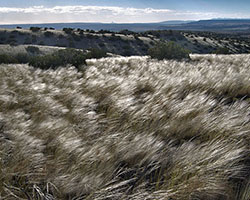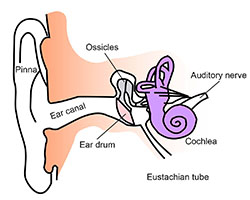
Illustrated by: David Kiersh

As you hike across a grassy field, the wind picks up and pushes against you. When you walk down the street, a bus passes by, blowing air and dust into your face. In the air all around you are small floating particles called air molecules. We only really notice these when the air moves enough for it to feel windy or breezy, but air molecules move all the time.
Usually air molecules create quiet sounds and small movements that we cannot hear or feel. But when something creates a strong enough vibration, like when someone claps their hands or when your vocal chords move when you talk, the air molecules get pushed into each other. This causes a wave of sound to travel through the air. Once those air molecules reach your ear, the movement of air causes a series of changes that result in you hearing a sound. So what changes take place that turn a sound wave into something you understand?
Into the Ear
Before we discuss how the ear works, we need to know some basic ear anatomy. Your ear has three sections: outer, middle, and inner. The outer ear is made up of your ear canal and ends at your eardrum, the tympanic membrane. Behind the tympanic membrane is your middle ear.

The middle ear is named very appropriately, as it connects the outer ear to the inner ear. Three bones form this connection and they are called ossicles. The three ossicles are the malleus, incus, and stapes. The ossicles together are smaller than a dime.
The last section of the ear is called the inner ear. This section is made up of the cochlea (pronounced coke-lee-ah). A cochlea looks just like a snail shell and is filled with fluid and nerves that send the sounds to your brain.
Bring in the Sound
Now, let’s get back to those air molecules. When the air molecules reach your ear, they travel through your ear canal until they bump into your eardrum.

Have you ever played with dominoes? You line them all up and push against the first one. This domino falls into the next one, making it fall into the next one, and so on. Sound works the same way. Every time sound hits something, it makes something else move. This is how sound moves down the pathway to get to your brain.
The air molecules moving through your ear canal cause the eardrum to move back and forth. The middle ear bones are connected to your eardrum and start moving back and forth too.
The back and forth motion of the bones pushes on a membrane of the cochlea called the oval window. Because the bones are pushing on the oval window, fluid starts moving back and forth inside the cochlea. When the fluid is moving, it moves tiny little cells called hair cells lined up inside the cochlea.
It's almost like sea grass being moved by the current. When fluid pushes on the hair cells, they are activated and send a neural signal to the auditory nerve. Signals travel through this nerve to your brain so that you can understand the message.
Breaking Down Sound
If all our hearing is caused by the movement of these connected parts, how is it that we can hear different sounds, from a tiny mosquito buzzing near your ear to the low blow horn of a ship? Well, the eardrum moves at different speeds depending on the sound.

High-pitched sounds, like birds singing, cause the eardrum to move fast. Low-pitched sounds, like the low hum of a hair dryer, cause the eardrum to move slowly. Once the fluid gets through to the inner ear, it moves that fluid inside the cochlea. The fluid moves at the same speed as the eardrum.
There are many hair cells inside your cochlea, but each only responds to a specific fluid speed. Some hair cells respond to slower-moving fluid. Other hair cells respond when the fluid moves fast. The auditory nerve gets information about the sound based on which hair cells are moving. This helps the brain decide what the sound is.
Additional images via Wikimedia Commons. Water ripples via Sergiu Bacioiu.
Read more about: How Do We Hear?
Bibliographic details:
- Article: How Do We Hear?
- Author(s): Emily Venskytis
- Publisher: Arizona State University School of Life Sciences Ask A Biologist
- Site name: ASU - Ask A Biologist
- Date published: 2 Feb, 2016
- Date accessed: 17 May, 2025
- Link: https://askabiologist.asu.edu/explore/how-do-we-hear
APA Style
Emily Venskytis. (Tue, 02/02/2016 - 09:26). How Do We Hear?. ASU - Ask A Biologist. Retrieved from https://askabiologist.asu.edu/explore/how-do-we-hear
Chicago Manual of Style
Emily Venskytis. "How Do We Hear?". ASU - Ask A Biologist. 02 Feb 2016. https://askabiologist.asu.edu/explore/how-do-we-hear
MLA 2017 Style
Emily Venskytis. "How Do We Hear?". ASU - Ask A Biologist. 02 Feb 2016. ASU - Ask A Biologist, Web. https://askabiologist.asu.edu/explore/how-do-we-hear

Waves move through air in a similar way to how ripples move through water.
Learn more about our five senses.
Be Part of
Ask A Biologist
By volunteering, or simply sending us feedback on the site. Scientists, teachers, writers, illustrators, and translators are all important to the program. If you are interested in helping with the website we have a Volunteers page to get the process started.






